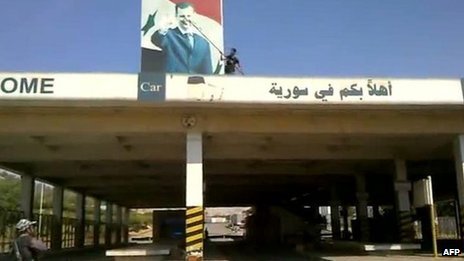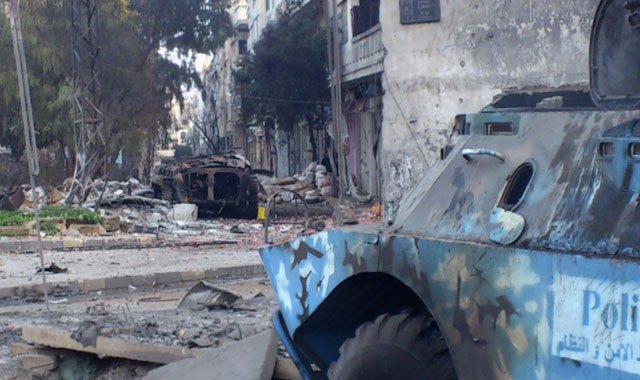Home Tags Posts tagged with "government forces"
government forces
Syrian rebels have captured a number of positions on the country’s borders with Iraq and Turkey.
A senior Iraqi official said all the crossings on Syria’s eastern frontier had been seized. At one point, two Turkish posts were also in rebel hands.
The push came a day after a bomb claimed the lives of three senior defence officials in Damascus.
At the UN, negotiations are under way on extending the mandate of the observer mission in Syria,
The mandate for the mission is due to expire on Friday.
There are almost 300 UN observers in Syria, but the mission suspended most of its monitoring activity in June, because of the risk from increasing violence.

Syrian rebels have captured a number of positions on the country's borders with Iraq and Turkey
The US says it might consider a final brief extension of the monitors work, but warned that it could not pin its policy on an unarmed mission.
The UK is proposing an extension for 30 days, and then the mission would continue only if the regime had removed heavy weapons from cities and sent troops back to their barracks.
The major Abu Kamal crossing on the Euphrates river in the east was captured after a clash with government forces, opposition activists said.
More than 20 Syrian soldiers and their commander were killed when a remote army outpost in the far north-east was attacked, Associated Press news agency reported.
Iraq’s government, seen as sympathetic to President Bashar al-Assad, has threatened to shut its side of the border and one official told Reuters news agency that it was closing the Abu Kamal crossing.
On the frontier with Turkey, too, rebels were said to have taken control of two posts, at Bab al-Hawa and Jarablus.
Video from the Bab al-Hawa crossing in Idlib province soon emerged of rebels defacing a portrait of President Assad, but they later reportedly withdrew from the position.
The regime’s grip on outlying areas may be slipping, which is hardly surprising given the fighting in Damascus.
State TV has been reporting on violence across the capital, showing footage of troops in the Midan area where it said 20 terrorists had been killed.
Analysts point out that the regime shows no signs of collapsing, and the military is still heavily armed, loyal and able to defend key institutions.
Violence broke out in the capital on Sunday, and two days later the rebels declared an all-out assault, calling it “Damascus volcano”.
The explosion on Wednesday that killed three top security officials led to a mobilization of government troops in an attempt to drive the rebels out of the city.
The president’s brother-in-law, the defence minister and head of the government’s crisis team were killed by a bomb as they attended a meeting at the national security headquarters.
The first images of President Bashar al-Assad since the attack have appeared, largely ending rumours he might have been hurt.
The footage appeared to show Gen Fahd Jassim al-Furayj, chief of staff of the armed forces, being sworn into his new post as defence minister.
Tanks and armored vehicles were reported to have moved into Qaboun on Thursday, close to the centre of Damascus.
There were heavy casualties, activists said, as a result of an army bombardment of Zamalka in the eastern outskirts of Damascus.
The London-based Syrian Observatory for Human Rights put the number of fatalities across the country on Thursday at 250.
The pace of events in Syria was in marked contrast to the diplomatic stalemate at the UN Security Council, where Russia and China vetoed a Western resolution calling for tougher sanctions on Damascus.
Under the Western-backed plan, the Damascus government would have been threatened with non-military sanctions under Chapter Seven of the UN Charter if it failed to move troops and heavy weapons from populated areas.
But the use of Chapter Seven paved the way for “external military involvement in Syrian domestic affairs”, Russia’s UN ambassador Vitaly Churkin argued.
According to reports from activists and residents, the Syrian capital Damascus has seen some of the heaviest fighting of the conflict so far.
Mortar and small-arms fire was reported in several areas as government forces clashed with the Free Syrian Army.
The fighting came as UN and Arab League envoy Kofi Annan prepared to meet Russia’s foreign minister for talks on the Syrian crisis.
Russia has been backing Syrian President Bashar al-Assad’s regime.
Kofi Annan is expected to urge Foreign Minister Sergei Lavrov to put pressure on the Syrian authorities to begin a political transition..
The International Committee of the Red Cross (ICRC) has said the conflict in Syria is now in effect a civil war.
It means combatants across Syria are now subject to the Geneva Conventions and could be liable for war crimes prosecution in the future.
The ICRC had previously regarded only the areas around Idlib, Homs and Hama as warzones.

Syrian capital Damascus has seen some of the heaviest fighting of the conflict so far
Clashes between government forces and Free Syrian Army rebels seem to be creeping ever closer to the heart of Damascus and the centre of the regime’s power.
Mortars were reportedly used on the southern edge of the city, in areas like Tadhamon and Midan and around nearby Palestinian refugee camps.
Activists said clashes continued into the early hours of the morning.
A convoy of army reinforcements was reported to have been attacked by rebels in Kfar Sousa to the west, leading to further clashes there.
Residents were said to be fleeing some areas, while in other parts of the city protesters blocked motorways with burning tyres.
There has been frequent trouble in these areas – barely three miles (4-5 km) from the centre – for months.
But as with many of the suburbs ringing the city slightly further out, all the government’s repeated efforts to stifle defiance have failed.
The government has denied that it had used heavy weapons in its attack on the village of Tremseh on Thursday.
Activists initially described fighting in Tremseh, which is near the city of Hama, as a massacre of dozens of civilians, but later accounts suggested most of the dead were armed rebels.
UN observers at the scene have said Syrian forces used heavy artillery, tanks and helicopters, but Damascus denies those allegations and said just two civilians had been killed.
The accusations, if proved, would mean Damascus had broken an agreement it made with UN and Arab League envoy Kofi Annan.
Further pressure was put on the government of President Bashar al-Assad when the International Committee of the Red Cross, which oversees the Geneva Conventions, said fighting had now spread beyond the three hotspots of Idlib, Homs and Hama.
Spokesman Hicham Hassan said Syria was now regarded as a “non-international armed conflict”, which is the technical term for civil war.
“What matters is that international humanitarian law applies wherever hostilities between government forces and opposition groups are taking place across the country,” he said.
The statement is significant because it is the Red Cross’ job to monitor the conduct of the fighting, and to tell warring parties what their obligations are.
Under the Geneva Conventions, indiscriminate attacks on civilians, attacks on medical personnel or the destruction of basic services like water or electricity are forbidden and can be prosecuted as war crimes.
From now on, all those fighting in Syria are officially subject to the laws of war, and could end up at a war crimes tribunal if they disobey them.
The ICRC’s announcement echoes both the UN’s head of peacekeeping Herve Ladsous and President Assad, who has said the country is at war.
Some 16,000 people are thought to have been killed since the uprising against Bashar al-Assad’s regime began in March 2011.
UN diplomats are attempting to agree a way forward for the organization’s monitoring mission in the country.
The mission’s mandate runs out on Friday, and Western nations are trying to get Russia and China to agree to a strengthened resolution authorizing sanctions.
Kofi Annan’s six-point plan:
1. Syrian-led political process to address the aspirations and concerns of the Syrian people
2. End to violence by all sides; army troops to stop using heavy weapons and withdraw to barracks
3. Parties to allow humanitarian aid
4. Authorities to free political detainees
5. Authorities to ensure freedom of movement for journalists
6. Authorities to allow peaceful demonstrations
[youtube 5w2hVdvArYw]
At least 47 people have been killed in an attack by pro-government militia in the embattled Syrian city of Homs, according to human rights activists.
Women and children are said to among those who were reportedly tortured and killed on Sunday night in the neighborhood of Karm el-Zeytoun.
The Syrian government acknowledged the deaths, but blamed “armed terrorists”.
The attack happened hours after UN-Arab League peace envoy Kofi Annan ended his two-day mission to Damascus.
Homs has been under assault for weeks as government forces have tried to root out rebel fighters. Parts of the city are devastated.
The main opposition group, the Syrian National Council (SNC), has called for an emergency UN Security Council meeting to discuss the killings, the AFP news agency reports.
Hundreds of families fled the Karm el-Zaytoun area of the city on Monday after reports of the attack in their neighborhood overnight, the British-based Syrian Observatory for Human Rights said.
One activist in Homs, Hadi Abdallah, told the AFP the bodies of 26 children and 21 women were found, some with their throats slit and others bearing stab wounds.

At least 47 people have been killed in an attack by pro-government militia in the embattled Syrian city of Homs
Both the opposition Syrian Revolution General Commission (SRGC) and the Local Coordination Committees (LCC) put the toll at 45.
The SRGC said that some of the victims had been burned alive with heating fuel poured over them and others had their necks and limbs broken.
Mulham al-Jundi, an opposition activist and member of the SNC, said Karm el-Zeytoun was experiencing a military bombardment similar to the one seen in Baba Amr district in recent weeks.
He said government troops were firing rockets from tanks outside the neighborhood, then going in “and killing the families who stay inside these areas”.
Reports are difficult to verify because of tight restrictions on independent media operating in Syria.
Footage posted on YouTube, said to show the bodies of men, women and children killed in the attack, made for grim viewing.
In one video, at least 11 bodies can be seen, including at least four young children covered in blood, he adds.
Syrian state television accused “armed terrorist gangs” of carrying out the killings, saying the bodies had been filmed in an effort to discredit the government.
Both the LCC and the British-based Syrian Observatory for Human Rights blame the pro-government Shabiha militia for the attack.
The Shabiha has been blamed for many of the atrocities carried out since the uprising began nearly a year ago.
Activists say their presence has allowed the government to deny any involvement in the most brutal actions against protesters.
Kofi Annan left Syria on Sunday after two days off talks with President Bashar al-Assad, saying he was “optimistic” that a peace deal could be found.
He said he had presented Bashar al-Assad with “concrete proposals” to bring an end to the bloodshed, but gave no hint that a deal was imminent.
Syria will be on the agenda when US Security Council foreign ministers meet in New York later.
[youtube H47eiZ7vjrs]



